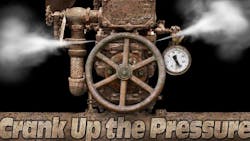Pneumatic System Designers: Don't Overlook Critical Backpressure
Charles Post, president of TSI Solutions is one of these experts. His expertise is in factory automation and pneumatics, and recently I came across a short piece he contributed to Hydraulics & Pneumatics several years ago. He explained critical backpressure, a basic concept that bears repeating. Charlie wrote:
One of the most confusing aspects of industrial pneumatic technology concerns the relationship between air pressure and air flow. We know that pressure is measured as force per unit area — typically in psi — whereas flow is measured as the volume of air that moves in a unit of time — typically in scfm.
If we need more force to move a load, we crank up the pressure. Because F = p × A, and area is constant, higher pressure generates more force. When we want to cycle faster, the tendency is to crank up the pressure again — perhaps on the assumption that it will have the same effect as pushing the gas pedal to make a car go faster.
The confusion begins because of the direct relationship between compressed-air flow and pressure. The only reason air will flow from point X to point Y is because a difference in pressure exists. Point Y must be at a lower pressure for air to flow toward it, similar to the flow of water from a higher elevation to a lower elevation. The greater the difference in pressure, the greater the flow of air — up to a point.
Just as an object falling from an airplane reaches a maximum speed, called terminal velocity, flowing air reaches a speed called critical velocity. This is the speed of sound — roughly 1,100 fps (750 mph). Air can flow no faster.
Critical velocity is achieved when downstream pressure is 53% or less of upstream pressure. In pneumatics, the 53% figure is known as critical backpressure. For example: if supply pressure is set at 75 psi, and air exhausts from a cylinder at 50 psi (67% of supply), you can increase the stroke speed by increasing the supply pressure. But with 95-psi supply pressure, the 50-psi exhaust pressure is 53%. Any increase in supply pressure cannot increase cylinder speed. It will only waste energy and strain components unnecessarily.
TSI Solutions, Stone Mountain, Ga., is provider of industrial automation components, systems, and services. Contact them at (770) 879-3500 or visit 4tsi.com.
About the Author
Alan Hitchcox Blog
Editor in Chief
Alan joined Hydraulics & Pneumatics in 1987 with experience as a technical magazine editor and in industrial sales. He graduated with a BS in engineering technology from Franklin University and has also worked as a mechanic and service coordinator. He has taken technical courses in fluid power and electronic and digital control at the Milwaukee School of Engineering and the University of Wisconsin and has served on numerous industry committees.

Leaders relevant to this article:

